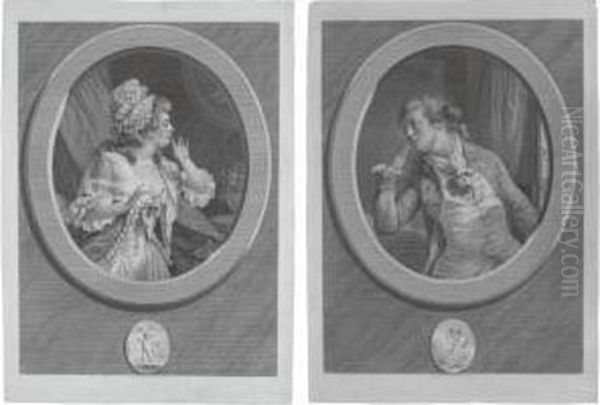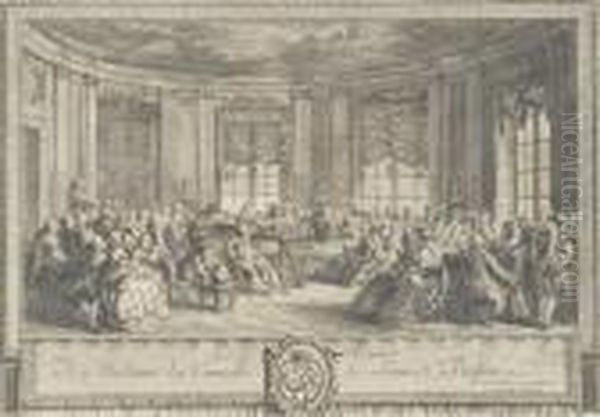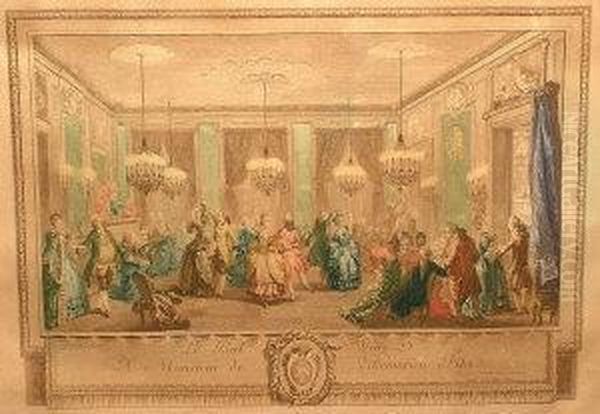Augustin de Saint-Aubin (1736-1807) stands as one of the most distinguished and prolific French engravers and illustrators of the 18th century. His life and career unfolded during a period of immense artistic and social transformation, bridging the Rococo's refined elegance with the burgeoning ideals of the Enlightenment and the nascent stirrings of Neoclassicism. Born into a family deeply embedded in the Parisian art world, Saint-Aubin's prodigious talent for detailed and delicate linework allowed him to capture the likenesses of prominent figures, illustrate celebrated literary works, and document the fashionable society of his time, leaving behind an invaluable visual record of an era on the cusp of revolution.
Early Life and Artistic Formation
Born in Paris in 1736, Augustin was immersed in art from his earliest days. He was the son of Charles-Germain de Saint-Aubin (1721-1786), himself an accomplished designer, embroiderer to the King, and author of L'Art du Brodeur (The Art of the Embroiderer). More significantly, Augustin was the younger brother of Gabriel de Saint-Aubin (1724-1780), a highly regarded painter, draftsman, and etcher known for his lively depictions of Parisian street life and public events. Gabriel's influence on Augustin's early artistic development was profound, providing him with initial instruction and fostering his innate talent for drawing and printmaking.
To further hone his skills, Augustin de Saint-Aubin entered the workshop of Étienne Fessard (1714-1777) in 1755. Fessard was a respected engraver and publisher, and under his tutelage, Augustin would have mastered the intricate techniques of line engraving and etching. He also studied with Laurent Cars (1699-1771), another prominent engraver known for his reproductive prints after contemporary painters like François Boucher and Jean-Baptiste-Siméon Chardin. This comprehensive training equipped Saint-Aubin with the technical virtuosity that would become a hallmark of his career.
Ascent in the Parisian Art World

Saint-Aubin's talent did not go unnoticed. He quickly established a reputation for the finesse and precision of his work. In 1771, he was approved (agréé) by the prestigious Académie Royale de Peinture et de Sculpture (Royal Academy of Painting and Sculpture) as an associate member. This was a significant step for any artist aspiring to official recognition. However, he never submitted the requisite "reception piece" (morceau de réception) to become a full academician, a curious omission that perhaps speaks to his independent spirit or his focus on the thriving market for prints outside the Academy's direct purview.
A pivotal moment in his career came in 1776 (some sources cite 1777) when he succeeded his former master, Étienne Fessard, in the esteemed position of "Graveur de la Bibliothèque du Roi" (Engraver to the King's Library). This royal appointment not only conferred considerable prestige but also provided him with a steady stream of commissions and access to the highest echelons of French society. He began to work for the family of King Louis XVI, further solidifying his status as a leading engraver of his generation. He also held a position in the household of the Duke of Orléans, though this was likely impacted by the Revolution.
Artistic Style and Technical Mastery
Augustin de Saint-Aubin was celebrated for his exquisite command of the engraver's burin and the etcher's needle. His style is characterized by an extraordinary delicacy of line, meticulous attention to detail, and a refined sensibility that perfectly captured the Rococo aesthetic's emphasis on elegance and charm. His portraits, in particular, demonstrate a remarkable ability to convey not only a physical likeness but also a sense of the sitter's personality and social standing.
He was adept at various printmaking techniques, primarily etching and line engraving. His etchings often possess a lively, almost sketch-like quality, while his engravings are marked by their precision and tonal richness. He skillfully employed cross-hatching and stippling to create subtle gradations of light and shadow, lending depth and volume to his figures and their surroundings. His compositions are typically well-balanced and harmonious, often incorporating decorative elements that enhance their visual appeal. While influenced by the prevailing Rococo style, especially in his earlier works, there are also elements of emerging Neoclassical clarity and restraint in his later productions, reflecting the shifting artistic tastes of the late 18th century.
Major Works and Thematic Concerns
Augustin de Saint-Aubin's oeuvre is vast and diverse, encompassing over 1300 prints. His works can be broadly categorized into portraits, book illustrations, and depictions of contemporary life and allegorical scenes.
Portraits:

Portraiture formed a significant part of Saint-Aubin's output. He engraved portraits of many of the leading figures of his day, including royalty, aristocrats, intellectuals, and fellow artists. Among his most famous sitters were Queen Marie Antoinette, the philosopher Jean-Jacques Rousseau, the writer Voltaire, the statesman Jacques Necker, and even later, a portrait of Napoleon Bonaparte. His small-scale medallion portraits, often set within ornate frames, were particularly popular and showcased his ability to capture a likeness with remarkable precision even in a diminutive format. An excellent example is his elegant oval portrait of the Marquise de Conti. These works were often influenced by the portrait style of Charles-Nicolas Cochin the Younger, but Saint-Aubin imbued them with his own distinctive decorative flair.
Book Illustrations:
Saint-Aubin was a highly sought-after book illustrator, contributing to some of the most important literary publications of the 18th century. His illustrations are prized for their sensitivity to the text, their narrative clarity, and their exquisite execution.
One of his early significant commissions, undertaken around 1757, was for a lavish edition of Giovanni Boccaccio's Decameron. For this project, he collaborated with other leading artists, including François Boucher and Charles-Nicolas Cochin, engraving designs by Gravelot, Boucher, Cochin, and Eisen.
He also produced a celebrated series of etchings for Ovid's Metamorphoses, demonstrating his skill in interpreting classical mythology with grace and imagination. His illustrations for works by Rousseau, Corneille, and Racine further cemented his reputation in this field. He also designed numerous frontispieces and vignettes, which were essential decorative elements in 18th-century book production. For instance, he created frontispieces and portraits for publications by the renowned publisher Antoine-Augustin Renouard, such as Tableau des portraits à la mode.
Scenes of Contemporary Life and Allegories:
Beyond portraits and illustrations, Saint-Aubin created prints depicting scenes of fashionable society, allegorical subjects, and historical events. His famous pair of prints, Au moins soyez discret (At Least Be Discreet) and Comptez sur mes serments (Count on My Oaths), are charming examples of Rococo genre scenes, capturing the playful gallantry of the era.
Perhaps his most iconic work in this vein is Le Concert (The Concert) and its companion piece Le Bal Paré (The Full-Dress Ball), often referred to together as Concert et spectacle paré. These large, intricate engravings, made after his own drawings, offer a vivid glimpse into the opulent social gatherings of the French aristocracy. They are remarkable for their detailed rendering of costumes, interiors, and the animated interactions of the figures, serving as invaluable documents of 18th-century social customs. He also created designs for ephemeral items like invitation cards and program bills, all executed with his characteristic elegance.
Collaborations and Artistic Circle
The Parisian art world of the 18th century was a tightly-knit community, and Augustin de Saint-Aubin was an active participant, collaborating with many of his contemporaries.

His relationship with Charles-Nicolas Cochin the Younger (1715-1790) was particularly significant. Cochin, a dominant figure in the French art establishment as an engraver, designer, and art theorist, recognized Saint-Aubin's talent early on. They collaborated on the Decameron illustrations, and it was Cochin who reportedly recommended Saint-Aubin for membership in the Royal Academy. Cochin's influence can be seen in Saint-Aubin's approach to small portraiture.
Saint-Aubin's teachers, Étienne Fessard and Laurent Cars, were important figures in their own right. Fessard was not only an engraver but also a publisher, providing a commercial outlet for prints. Cars was known for his reproductive engravings after major painters like François Boucher (1703-1770), the leading exponent of the Rococo style, and Jean-Baptiste-Siméon Chardin (1699-1779), celebrated for his still lifes and genre scenes. Saint-Aubin himself would later engrave works after Boucher.
He collaborated with his fellow student under Fessard, Jean-Baptiste Tiliard (or Tillard, c. 1740-1813), on series such as Les différends des petits polissons and Mes Gens.
Hubert-François Gravelot (1699-1773) was another key figure in book illustration whose designs Saint-Aubin engraved. Gravelot, along with Cochin and Charles Eisen (1720-1778), was a leading designer of book illustrations, and Saint-Aubin's role was often to translate their drawings into the engraved medium.
Among his students was Antoine-Jean Duclos (1742-1795), who became a notable engraver and often reproduced Saint-Aubin's own designs. Duclos himself collaborated with Cochin and Gravelot on projects like the Almanach iconologique. Saint-Aubin's work also inspired other engravers, such as Pierre-François-Léonard Courtois.
He also worked with the publisher Antoine-Augustin Renouard (1765-1853), a significant figure in the book trade during and after the Revolution, for whom Saint-Aubin designed frontispieces and portraits.
While primarily an engraver, Saint-Aubin's work existed within a broader artistic landscape that included painters like Jean-Honoré Fragonard (1732-1806), known for his exuberant Rococo scenes, and Jean-Baptiste Greuze (1725-1805), who specialized in sentimental genre paintings and moralizing subjects. Towards the end of Saint-Aubin's career, the dominant artistic force became Jacques-Louis David (1748-1825), the champion of Neoclassicism, signaling a profound shift in artistic taste away from the Rococo elegance that had characterized much of Saint-Aubin's era. Other engravers of note during this period included Nicolas-Henri Tardieu (1674-1749), with whom Saint-Aubin also collaborated.
The Saint-Aubin Family of Artists
Augustin was not the only artist in his family; the Saint-Aubins were a veritable dynasty of talent. His elder brother, Gabriel de Saint-Aubin, was arguably more famous in his own time as a painter and etcher of Parisian life, though his work was perhaps less commercially polished than Augustin's engravings. Gabriel's spontaneous and lively style contrasted with Augustin's more meticulous approach, but both brothers shared a keen observational skill and a dedication to their craft. Their father, Charles-Germain de Saint-Aubin, as mentioned, was an accomplished designer and embroiderer, contributing to the artistic environment in which his sons were raised. There were other siblings involved in the arts as well, including Louis-Michel de Saint-Aubin (designer and pastellist), and sisters who were skilled in embroidery and drawing. This familial context undoubtedly played a crucial role in shaping Augustin's career path and artistic sensibilities.
Patronage and the Social Milieu
Augustin de Saint-Aubin's career flourished thanks to a diverse network of patrons and a society that highly valued finely crafted prints. His appointment as Engraver to the King's Library placed him directly within the orbit of royal patronage. He also received commissions from other members of the nobility, such as the Duke of Orléans.
Beyond aristocratic patronage, the burgeoning middle class and the thriving publishing industry provided a significant market for his work. Book illustrations were in high demand, and individual prints, especially portraits and genre scenes, were popular collectibles. Publishers like Renouard played a crucial role in commissioning and disseminating prints to a wider audience. Saint-Aubin's ability to capture the elegance and refinement of his era made his work particularly appealing to a clientele that aspired to taste and sophistication. His prints not only served as works of art but also as records of fashion, social customs, and prominent personalities, reflecting the cultural preoccupations of 18th-century France.
Anecdotes and Personal Interests
While much of Saint-Aubin's life revolved around his prolific artistic production, a few anecdotes offer glimpses into his personality and the challenges he faced.
One notable incident involved a dispute over copyright, a recurring issue for artists in an era before robust intellectual property laws. In 1788, Saint-Aubin discovered that a fellow engraver named Delaunay (likely Nicolas Delaunay or Robert Delaunay, both active engravers) had copied and was selling his engraved portrait of Jacques Necker, the popular finance minister. This unauthorized reproduction directly undercut Saint-Aubin's own sales of the print, leading him to initiate legal action. This event highlights the competitive nature of the print market and the artists' struggles to protect their original creations.
Beyond his artistic pursuits, Saint-Aubin reportedly had an interest in philosophy and religion. There are accounts of him discussing subjects like astrology with friends, expressing a degree of skepticism characteristic of the Enlightenment's emphasis on reason. These intellectual interests may have informed the thoughtful and perceptive quality evident in many of his portraits and allegorical works.
Later Years and Lasting Legacy
Augustin de Saint-Aubin continued to work productively throughout the tumultuous years of the French Revolution and into the Napoleonic era. The societal upheavals undoubtedly impacted his patronage and subject matter, but his skill as an engraver remained in demand. He adapted to changing tastes, and his later works sometimes reflect the more austere Neoclassical style that came to dominate French art.
He passed away in Paris in 1807, leaving behind an immense body of work that stands as a testament to his skill, diligence, and artistic vision. His prints are highly valued by collectors and museums worldwide, not only for their aesthetic qualities but also for the rich historical information they provide. He is remembered as one of the foremost masters of 18th-century French engraving, an artist who expertly captured the spirit of his age.
His influence extended through his students and the many engravers who emulated his style. More broadly, his work contributed to the high esteem in which French printmaking was held throughout Europe. The sheer volume and consistent quality of his output are remarkable, and his prints continue to be studied for their technical brilliance and as invaluable documents of 18th-century French culture, society, and portraiture.
Conclusion
Augustin de Saint-Aubin was more than just a skilled craftsman; he was a sensitive interpreter of his time. Through his meticulous engravings and etchings, he provided a window into the world of pre-Revolutionary France, capturing its elegance, its intellectual ferment, and its leading personalities. From intimate portraits to grand illustrations and lively social scenes, his work embodies the refined aesthetics of the Rococo while also reflecting the intellectual currents of the Enlightenment. As a key member of a distinguished artistic family and a respected figure in the Parisian art world, Augustin de Saint-Aubin's legacy endures, his prints cherished as masterpieces of 18th-century graphic art and as vital historical records of a fascinating and transformative era.